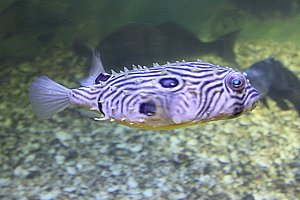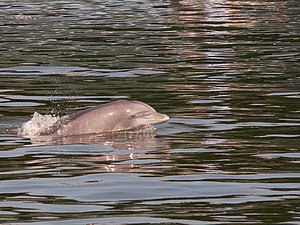Research on Marine Life Impacts
Research on the effects of seismic airgun blasting and ocean noise to marine life indicates that the impacts range from harassment to injury - to even death. It is very difficult to measure the effects of seismic airgun blasting on marine life, especially in the wild, as the animals may dive below the surface at the onset of the noise, where they cannot be observed, and any internal injuries are also not observable.
The following are recent comments, reports, and letters from top marine scientists and government agencies regarding seismic blasting.
- NOAA Fisheries recently issued Incidental Harassment Authorization (IHA) for the unintentional (i.e., incidental) taking of marine mammals.
- In a recent letter to the President, 75 top marine scientists oppose seismic testing in the Atlantic and address concerns for marine life. Read the letter here.
- The Natural Resources Defense Council (NRDC) also recognized the letter and the potential harms. See their press release here.
- The New Jersey Department of Environmental Protection (NJDEP) also find the proposed study inconsistent with NJ's Coastal Zone Management Rules. To review their comments, please visit this link.
- To view comments submitted by Clean Ocean Action, The Center for Biological Diversity, and 13 other organizations, please visit the comments here.
- The Marine Mammal Commission reviewed the application submitted by LDEO and provided detailed suggestions for this study.
- In a letter dated May 22, 2015, U.S. Senator Cory Booker wrote to the administrator of the National Oceanic and Atmospheric Administration (NOAA) asking her to withdraw the final IHA and "re-notice the proposed authorization with the correct numbers of marine mammals to be harassed, based upon the correct methodology, so that the public can adequately review and comment upon this project."
- In a letter to the President of Rutgers University, NJ Senate President Sweeney and Congressman Pallone asked President Barchi him to cancel the study or schedule it for another time of year.
- The NJDEP Commissioner Martin wrote a letter formally requesting the Director of the National Science Foundation to postpone the seismic testing study.
- The NJDEP filed a complaint in the US District court for injunctive and declaratory relief regarding the seismic study.
- The Recreational Fishing Alliance filed a memorandum of law and complaint against the seismic study.
Below is an overview of the current state of scientific understanding and links to studies that provide more information on the effects to marine life.
Fish 
Fish experience severe impacts from the use of seismic airguns, ranging from serious injury at close range to avoidance behavior at distances of up to several miles from a source. Scientists have found that the ears of many marine fish species are more sensitive than even certain whales at frequencies commonly used in seismic airgun blasting.1 Furthermore, the air-filled swim bladder possessed by bony fish put them especially at risk of injury from intense sound.2 Studies on fish response to sound have revealed, for example, that fin-fishes exhibit general alarm behavior at a received sound level of 156-168 dB re: 1 µPa rms.3 Following exposure to airgun pulses, researchers observed extensive pathological damage to the ears of pink snapper (Chrysophrys auratus), including ablated (i.e., removed) hair cells and injured sensory epithelia (i.e., tissues involved in hearing).4
Species of Particular Concern
Atlantic Sturgeon have existed for over 150 million years. These prehistoric creatures have been recorded at lengths reaching 15 feet and weights topping 800 lbs. Throughout the 19th and 20th centuries, Atlantic sturgeons were critical to commercial fisherman on the Atlantic Coast. In 2015, less than 5,000 individuals in the North Atlantic stock have been estimated to remain. Harvesting Atlantic Sturgeon was a huge part of commercial industry, as sturgeon eggs were in high demand for their use as cavier. In 1998, the Atlantic Marine Fisheries Commission closed the East coast to the fishing of sturgeon - both recreational and commercial - for the next 4 decades in order to help populations grow.
This species was removed from the Rutgers Seismic Study Incidental Harassment Authorization, prompting Clean Ocean Action to write letters to Dr. Sullivan and Division Chief Peterson of NOAA, requesting that they re-initiate the Endangered Species Act consultation process, which would asses the potential impact of seismic testing on the species. There are a number of studies that show that this species have been and are likely to be in the area of the proposed study during peak summer months, which means that they have the potential to be adversely affected by the seismic testing.
Please view the following studies:
Atlantic States Marine Fisheries Commission By Catch Report
Invertebrates 
A study published in 2013 found that scallop larvae exposed to recordings of seismic airgun blasts exhibited significant developmental delays and growth abnormalities, which may lead to population-level effects in the wild as a result of reduced recruitment.5
A 2011 study of the effects of low-frequency sound on four cephalopod species documented acute physical damage to hair cells within the sensory epithelia.6 The researchers exposed four species of squid and cuttlefish to two hours of low-frequency sound pulses with a received pressure level of 157 +/-5 dB re: 1 µPa2, peaking at 175 dB re: 1µPa2.7 The study reported, "Exposure to low-frequency sounds resulted in permanent and substantial alterations of the sensory hair cells of the statocysts, the structures responsible for the animals' sense of balance and position." Even shorter exposure durations have been linked to severe pathological effects in squid. Lethal effects were observed in European squid (Loligo vulgaris) subjected to sound at 246 to 252 dB within three (3) to 11 minutes of the start of exposure.8
Sea turtles 
Studies on sea turtle response to operating airgun arrays have demonstrated marked behavioral changes at sound levels significantly below those commonly used in seismic testing. For example, trials on captive loggerhead and green sea turtles with a single airgun demonstrated that the individuals significantly increased their swimming activity at levels above 166 dB re: 1 µPa rms, and began swimming erratically at levels above 175 dB re: 1 µPa rms.9 Such behavioral shifts in a captive setting are expected to correspond with avoidance behavior in the wild.
Marine mammals 
According to the National Marine Fisheries Service, seismic testing can disrupt marine mammal behavioral patterns, including, but not limited to, migration, breathing, nursing, breeding, feeding, or sheltering. Relevant scientific literature indicates that more serious impacts, including temporary threshold shifts (TTS) (i.e., temporary hearing loss) can occur in marine mammals at sound intensities lower than used in a typical seismic survey; for example:
- A captive harbor porpoise was exposed on three occasions to one airgun firing at an average source level of 201 decibels (dB) re: 1 µPa2 peak-to-peak.10 In addition to avoidance behavior exhibited by the animal during the trials, the researchers noted the onset of TTS that did not fully subside until an estimated 55 hours after exposure.11
- Groups of humpback whales in the wild have been observed to exhibit avoidance behaviors at a distance of two kilometers (~1.25 miles) from a small airgun array; the received levels in these trials were 159 dB re: 1 µPa2 peak-to-peak.12
- Researchers tracked a blue whale traveling and vocalizing in the vicinity of a vessel firing a four-airgun array with a source level of 215 dB re: 1 µPa2 peak-to-peak and noted that at a distance of 10 kilometers (~6.2 miles) from the vessel (where the received level was estimated at 143 dB re: 1 µPa2 peak-to-peak); the whale ceased vocalizations for an hour and changed course dramatically.13
- Controlled exposure trials in which harbor seals were exposed to small airguns firing for one hour at source levels ranging from 215 to 224 dB re: 1 µPa2 peak-to-peak revealed dramatic physiological and behavioral responses, including a fright response evidenced by significant drops in heart rate; decreased stomach temperatures indicating a cessation of feeding; and rapid swimming away from the noise source.14
----------------------------------------------------------------------------------------------------
References:
[1] Turnpenny, A.W.H. and Nedwell, J.R. 1994.The effects on marine fish, diving mammals and birds of underwater sound generated by seismic surveys. Fawley Aquatic Research Laboratories Ltd., FCR 089/94:1-40.
[2] Gordon, J.C.D., Gillespie, D., Potter, J., Frantzis, A., Simmonds, M.P., Swift, R., and Thompson, D. 2004. A Review of the Effects of Seismic Survey on Marine Mammals. Marine Technology Society Journal 37: 14-32.
[3] McCauley, R.D., Fewtrell, J., Duncan, A.J., Jenner, C., Jenner, M-N., Penrose, J.P., Prince, R.I.T., Adhitya, A., Murdoch, J., and McCabe, K. 2000. Marine seismic surveys – A study of environmental implications. Appea Journal 692-708.
[4] McCauley, R.D., Fewtrell, J., and Popper, A.N. 2003. High intensity anthropogenic sound damages fish ears. Journal of the Acoustical Society of America 113: 638-642.
[5] Aguilar de Soto, N., Delorne, N., Atkins, J., Howard, S., Williams, J. and Johnson, M. 2013. Anthropogenic noise causes body malformations and delays development in marine larvae. Nature Scientific Reports 3: 2831-5.
[6] André, M., Solé, M., Lenoir, M., Durfort, M., Quero, C., Mas, A., Lombarte, A., van der Schaar, M., López-Bejar, M., Morell, M., Zaugg, S., and Houégnigan, L. 2011. Low-frequency sounds induce acoustic trauma in cephalopods. Frontiers in Ecology and the Environment 9: 489–493.
[7] Id.
[8] Norris, K.S. and Mohl, B. 1983. Can odontocetes debilitate prey with sound? The American Naturalist 122: 85-104.
[9] McCauley, R.D., Fewtrell, J., Duncan, A.J., Jenner, C., Jenner, M-N., Penrose, J.P., Prince, R.I.T., Adhitya, A., Murdoch, J., and McCabe, K. 2000. Marine seismic surveys – A study of environmental implications. Appea Journal 692-708.
[10] Lucke, K., Siebert, U., Lepper, P.A., and Blanchet, M.-A. 2009. Temporary shift in masked hearing thresholds in a harbor porpoise (Phocoena phocoena) after exposure to seismic airgun stimuli. Journal of the Acoustical Society of America 125: 4060-4070.
[11] Id.
[12] McCauley, R.D., Jenner, M.N., Jenner, C., McCabe, K.A., and Murdoch, J. 1998. The response of humpback whales (Megaptera novaeangliae) to offshore seismic survey: Preliminary results of observations about a working seismic vessel and experimental exposures. Appea Journal: 692-706.
[13] McDonald, M.A., Hildebrand, J.A., and Webb, S.C. 1995. Blue and fin whale observed on a seafloor array in the Northeast Pacific. Journal of the Acoustical Society of America 98: 712-721.
[14] Thompson, D., Sjoberg, M., Bryant, M.E., Lovell, P., and Bjorge, A. 1998. Behavioral and physiological responses of harbour (Phoca vitulina) and grey (Halichoerus grypus) seals to seismic surveys. Report to European Commission of BROMMAD Project. MAS2 C7940098.
Study Links
(Note: only studies that are freely available online are provided here)
Anthropogenic noise causes body malformations and delays development in marine larvae
Responses of cetaceans to anthropogenic noise
Marine seismic surveys: A study of environmental implications
High intensity anthropogenic sound damages fish ears
Changes in humpback whale song occurrence in response to an acoustic source 200 km away
A review of the effects of seismic survey on marine mammals
Considering the temporal and spatial scales of noise exposures from seismic surveys on baleen whales
Understanding the impacts of anthropogenic sound on beaked whales
The effects of seismic airguns on cetaceans in UK waters
Seismic surveys negatively affect humpback whale singing activity off Northern Angola

